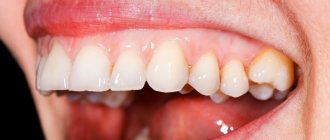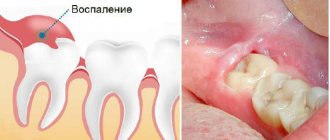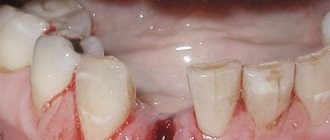Pain after tooth extraction: how long does it last, and is it normal? These and other questions concern patients after dental procedures. Pain syndrome is normal in several cases: early postoperative period, complex removal, simultaneous implantation.
Normally, pain can persist from several days to a week, and its intensity should decrease. The appearance of symptoms such as increased pain, swelling, inflammation, bleeding or the appearance of purulent exudate is a reason to immediately consult a doctor.
How does a postoperative wound heal?
How long the area hurts after tooth extraction depends on many factors. The healing process after tooth extraction is a complex and lengthy process. Removal occurs with a rupture of the dentofacial connection, namely the connection with the alveolar process and the jaw bone.
The recovery process lasts about two to three weeks. Much depends on the surgical protocol, the clinical situation and the characteristics of the body.
Main stages:
- Formation of a blood clot. Forms 1.5-3 hours after extraction. The function of the clot is to protect the wound area from pathogens and secondary infection.
- Active tissue regeneration. The affected mucous membranes are restored, after 3-4 days swelling and inflammation decrease.
- Formation of granulation tissue. After 4-6 days, granulation tissue forms on top of the clot - the basis of a new epithelial layer.
- Granulation proliferation. After a week, the granulation tissue grows, completely covering the socket.
Already on the eighth to tenth day, the wound is completely healed and by the end of the second week a new epithelial layer is formed.
After two weeks, bone tissue begins to renew. After six months, the bone tissue in the area of removal becomes completely healthy.
How long can gums hurt and what affects the duration of pain?
The strength and severity of pain depends on the complexity of the operation. If the tooth was mobile and was in the root, the patient may not experience discomfort at all. If it is necessary to cut out part of the bone and apply sutures, pain for 7 days is normal.
Usually the gums do not hurt for more than 7 days. During this period, the hole heals completely. If you encounter a similar problem, you need to urgently consult a dentist. The NAVA dental clinic in Moscow uses modern equipment, thanks to which inflammation can be easily removed in the early stages. If the problem is neglected, treatment may be difficult.
Pain in the gums can persist for several days and depends on what type of tooth extraction operation was performed:
- Milk tooth – 1-2 days.
- First and second molars – 2-3 days.
- The procedure with cutting out teeth takes 5-7 days.
- Removal of several adjacent teeth – 3-5 days.
- Fang – 2 days.
Causes of pain
The occurrence of pain after tooth extraction is associated with damage to nerve endings, vascular structures and soft tissues. The peak intensity of pain occurs in the first hours after the cessation of anesthesia. The symptom persists for about 12 hours.
In case of incisions in the gums or damage to the bone tissue, as well as after implantation after removal, toothache may persist for 2-3 days. Pain syndrome also occurs in the case of displacement of the dentition towards the formed void. Therefore, doctors recommend prosthetics as soon as possible after extraction.
Healing of the extracted tooth socket
METROGYL DENTA® is used for complex treatment and prevention of post-extraction alveolitis (inflammation of the socket after tooth extraction). The use of the drug helps eliminate inflammation by suppressing the activity of pathogens inhabiting the oral cavity. To prevent post-extraction alveolitis, the tooth socket after extraction is treated with METROGIL DENTA® gel and then the drug is applied for 7-10 days 2-3 times a day. METROGYL DENTA® has a good safety profile and is suitable for the treatment of periodontal diseases and mucous membranes of the cavity, starting from the age of 18.
Up to contents
The information in this article is for reference only and does not replace professional advice from a doctor. To make a diagnosis and prescribe treatment, consult a qualified specialist.
Pain during difficult removal
The duration of pain after complex extraction (wisdom teeth, impacted or dystopic incisors) is associated with damage to a larger tissue area. Often such an operation involves making an incision in the gum, sawing out the roots, extracting tooth fragments, and draining an abscess, which increases the scope of the surgical intervention. If your ear hurts after wisdom tooth removal, this may indicate nerve damage.
In some cases, patients complain of persistent discomfort and pain for up to a week. Clinical manifestations such as swelling, swelling of the gums, enlarged submandibular lymph nodes, fever, and malaise are also common.
Symptoms of a cyst after tooth extraction
One of the main problems associated with cysts concerns diagnosis: this complication can go almost unnoticed for a long time. Among the symptoms that one way or another manifest themselves during the development of pathology are the following:
- discomfort and pain when biting;
- aching pain, which in the later stages can develop into acute pain;
- a feeling of heaviness and interference in the area of the diseased tooth;
- development of sinusitis (especially if the cyst is located in close proximity to the maxillary sinus);
- malaise, weakness, slight increase in temperature.
Types of pain
The nature and type of pain depends on the type and surgical intervention, the duration of the operation, and the complexity of the clinical process. Clinicians distinguish the following types:
- Aching. It is felt immediately after the anesthesia wears off. Keeps for about 2-4 days. The jaw may ache when opening the mouth or chewing.
- Intense, enduring. Occurs during extraction of a complex tooth with drainage or opening of a purulent cavity.
- Phantom. Occurs after traumatic surgery and may be felt from time to time. Phantom pain occurs with weak immunity and a low pain threshold.
It is difficult to say how intense the pain will be in each specific case, which is why it is so important to follow medical recommendations to prevent complications.
Types of deletion
A dental cyst can be treated using one of the following surgical methods:
- Cystectomy is the most common way to remove cysts on teeth. During this operation, an incision is made on the gum, through which both the benign neoplasm and the apex of the tooth root with pathology are removed. The cystectomy procedure is usually performed under local anesthesia, after which the doctor prescribes antibiotics to the patient.
- Hemisection - this type of removal is used if a tooth with a cyst has more than one root, and at least one of them is pathologically changed. During this procedure, the cystic formation, the root of the tooth with pathology, and part of the tooth itself are removed. After this operation, a crown is placed on the tooth.
- Cystotomy is the most gentle type of surgical treatment for dental cysts, in which the doctor removes only the front wall of the tumor. The tooth body is completely preserved.
These techniques are an alternative to the complete removal of teeth with cysts. But it is not always possible to apply them. To completely remove teeth with benign tumors, the extraction method is used. The operation can be performed urgently or planned.
What else can pain indicate?
Severe pain after removal may indicate the development of complications. Pulsating pain that radiates to the ears and submandibular lymph nodes is not normal. The most common causes of complicated postoperative pain are the following factors:
- Violation of treatment protocol. Unfortunately, mistakes do occur, especially in the removal of complex teeth. The techniques and approaches used in different clinics may differ from the standards. Errors include leaving fragments of materials or a splintered tooth root behind.
- Alveolitis. Occurs in the absence of a blood clot. The disease complicates natural healing and interferes with normal tissue regeneration. That is why doctors do not recommend touching the wound with your tongue or rinsing your mouth intensively.
- Dry hole. One of the common complications and the cause of long-term pain after tooth extraction. Despite the moisture of the mucous membranes, bone tissue is visible at the bottom of the wound opening. This problem is typical for smokers during periods of hormonal surges. The doctor seals the wound with a swab containing medication.
- Trigeminal neuritis. Long-term pain persists when a tooth in the mandibular row is removed if the trigeminal nerve is damaged during the manipulation. Damage may be accidental due to structural anomalies or multiple branching of nerve structures.
The likelihood of complications developing is low if the removal protocol, medical recommendations after extraction, and timely response to alarming manifestations are followed.
Experts' opinion
Question: Is it possible to avoid the occurrence of a cyst on a tooth?
Answer : The etiology of the formation of a cyst at the root of a tooth can be different. At the initial stages, treatment of this pathology does not pose a serious problem. Therefore, it is very important to be regularly examined by a dentist, and also to take x-rays or visiography at least once a year to identify any pathologies of the dental system. New growths, if present, will also be visible on the images. To reduce the likelihood of tumors appearing, if any diseases of the oral cavity and nasopharynx occur, it is necessary to treat them in a timely manner: develop the habit of regularly rinsing your mouth with antiseptics, and learn to brush your teeth correctly. Maintaining a healthy lifestyle, a balanced diet, a strong immune system and preventive dental examinations are the key to dental health.
Question: Is it possible to get rid of a cyst on a tooth at home on your own?
Answer : We do not recommend self-medication if you have any pain or unpleasant symptoms in the oral cavity. Any discomfort may be a sign of a serious illness that requires medical attention. If it is not possible to urgently visit the dentist, then to reduce pain you can use the following rinses: herbal decoctions (yarrow, calendula, sage, chamomile, oak bark), a solution of baking soda or salt, vodka, tea tree essential oil. This may help reduce pain, but in any case you should see a doctor as soon as possible.
How can you reduce pain?
In the early postoperative period, it is important to follow basic recommendations that reduce the risk of negative manifestations:
- maintain the integrity of the blood clot - do not touch the wound with your tongue, rinse vigorously with solutions or water, just take an antiseptic or herbal decoction into your mouth, hold for a few minutes and spit;
- after a complex removal, take broad-spectrum antibiotics - this is important to prevent the infectious process;
- taking symptomatic medications for up to 2-3 days - in the first days, medications help reduce pain and inflammation;
- use a gel with a cooling effect for intense pain;
- do not eat for two hours after surgery, and eat solid food in the area of manipulation for 5-7 days.
You can reduce the pain if you chew a piece of ginger or propolis on the healthy side of the jaw, apply ice through a handkerchief to your cheek or chin, and rinse with the following ingredients:
- tea tree (10 drops per 500 ml of boiled water);
- steep chamomile decoction;
- decoction of eucalyptus and string;
- soda-salt solution (1 tsp soda, 1 tsp salt, 500 ml water).
The temperature of rinsing solutions should be comfortable - neither cold nor hot. Herbal solutions are best used as an alternative 3-5 days after surgery. In the early period, it is better to rinse the wound and oral cavity generously with water-based antiseptics.
The appearance of pain after tooth extraction is associated with trauma to the deep layers of the jaw structures. The tooth can hurt from several hours to 3-7 days, depending on the severity of the clinical situation and the scope of medical intervention. If questionable symptoms or other signs indicating complications appear, it is recommended to consult a doctor.
Is a tooth cyst a death sentence or not?
A dental cyst is a pathological neoplasm inside the bone tissue of the jaws as a result of the body’s defensive reaction to infection or injury. A dental cyst, as a rule, has an epithelial membrane and is filled with cystic exudate. The cyst in most cases has a chronic course and continuous growth.
A dental cyst has several stages of development: granuloma (small, less than 5 mm in diameter); cystogranuloma (up to 1 cm in diameter); cyst (more than 1 cm in diameter)
Reasons for the formation of cysts in the maxillofacial area:
- endodontic treatment of root canals . The tooth canal has more than one nerve trunk; it has many lateral branches. When treating the root canal of a tooth, infected tissue remains in these lateral micro-branches and after abturation of the canal a chronic inflammatory process can begin. Initially, a small granuloma (destruction of bone tissue) is formed, which eventually develops into a cyst. The simpler the anatomy of the root canal and the more accurately the treatment protocol for complicated caries is carried out, the lower the risk of developing cysts. In multi-rooted teeth with complex anatomy of the root system (bent, curvature, scarring, difficult access), the likelihood of developing root cysts increases significantly.
- Acute dental trauma. If a tooth has suffered trauma (impact), you should consult a doctor. Death of a nerve in a tooth or rupture of the neurovascular bundle may be invisible at first after injury and not cause concern to the patient. But such a tooth needs to be observed for several years, control x-rays taken, in which the doctor will be able to notice changes in the bone tissue in time and thereby prevent the formation of a root cyst on the root of the tooth.
- Chronic injury. There are two main reasons for this. One of them is long-term overload of the tooth as a result of missing neighboring teeth or a large number of lost teeth. This also includes occlusal supracontacts as a result of improper prosthetics or tooth treatment. The second is a vital (living) tooth covered with a crown. According to statistics, in 10% of such cases there are complications - nerve death. And if this is asymptomatic, then over time a cyst will form on the root of the tooth.
- Complications of other diseases. A root cyst of a tooth as a result of chronic sinusitis or a lateral cyst of a tooth as a result of chronic periodontitis. It is extremely rare that we encounter the formation of a cyst as a result of the transfer of infection by the bloodstream in any general somatic disease.
- Retention cyst . Cyst of an unerupted tooth. This is usually a wisdom tooth cyst. But cysts of other impacted teeth also occur.
- Residual cyst. The remaining cyst after tooth extraction. It can also increase in size and can lead to an inflammatory process. And most importantly, in the presence of such a cyst, it is not possible to carry out two-stage dental implantation.
Clinical symptoms of a dental cyst
- Asymptomatic. The course can last for years. The patient does not notice anything at all and nothing bothers him. The cyst is discovered by chance during an X-ray examination
- Chronic course. The patient can palpate (with his finger) the formation of some kind of tubercle in the area of the apex of the tooth root; discomfort when pressing; slight redness or minor pain symptoms that periodically make themselves felt. When visiting a doctor and R-graphic examination, the presence of a cyst in this area is determined.
- Acute course. With an exacerbation of the chronic process, the cyst suppurates and pain, swelling, redness, temperature, and general malaise appear. Pain appears when pressing on the causative tooth, which intensifies with chewing. A fistulous tract may form in the area of the root apex. Regional lymph nodes are involved in the process.
Consequences of an untreated dental cyst
The consequences of a cyst include, first of all, the likelihood of its exacerbation and the development of periostitis, purulent abscess or osteomyelitis. Inflammation of the cyst is quite pronounced and often ends with tooth extraction and can lead to short-term disability. If the patient at this stage does not consult a doctor and does not receive qualified dental care, sepsis may develop. This is an extremely serious condition, characterized by infection entering the blood and spreading throughout the body.
As a result of an asymptomatic course, the cyst gradually increases in size, destruction (destruction) of the bone tissue around the tooth occurs. The cyst can reach several centimeters in diameter and in this case the likelihood of complications is very high.
Here, for example, are some complications of an overgrown cyst:
- destruction of the bottom of the maxillary sinus, germination into it and, as a result, sinusitis.
- destruction of the cortical plate of the alveolar process and, as a consequence, the formation of a fistulous tract and the impossibility of installing an implant subsequently.
- growth of the cyst into the canal of the mandibular nerve, leading to neuritis.
- the growth of a cyst on the lower jaw can lead to a pathological fracture of the jaw.
- the growth of the cyst leads to the involvement of the roots of neighboring teeth in the pathological process and, as a result, their removal (removal of completely healthy teeth!)
Treatment methods for dental cysts
1. Conservative treatment
This type of treatment allows you to save the tooth. The dentist creates access to the root canal of the tooth, opens it and cleans it. Since the apex of the tooth is connected to the root cyst, the contents of the cyst emerge from the canal. After antiseptic and mechanical treatment of the root canal, it is filled with special calcium-containing pastes. Treatment lasts from 1 to 6 months, depending on objective data and the patient’s ability to visit a doctor.
Only after 6 months, on a repeated R-graph of the tooth, one can see the regeneration of bone tissue, the formation of bone balls in the area of the cyst and say with confidence about the success of the conservative method.
In our Euro Dentistry clinic, dental therapists have extensive experience in treating dental cysts using a conservative method, have a large percentage of cases of successful bone tissue regeneration, and fight for each tooth together with the patient. Only in the most critical cases do they abandon this method and send the tooth for extraction.
2.Surgery.
Here, too, not everything is clear. There are several methods of surgical treatment of root cysts. These are:
— Cystectomy operation with resection of the root apex. This is the removal of the cyst and part of the damaged root. The method is highly effective, but is quite complex and requires highly qualified specialists.
- Hemisection. In this case, one root is removed from a multi-rooted tooth. The doctor removes the cyst, the damaged root and part of the tooth crown, and the tooth is covered with a crown. The method is less effective, complex and unpredictable.
- Removal of a tooth. It is carried out with the obligatory removal of the cyst capsule to avoid relapse.
At Euro Dentistry in Vitebsk, after examining the patient, clinic specialists will make a final diagnosis and offer the best treatment option for the dental cyst. A cystectomy or tooth extraction along with a cyst will be performed without pain.











